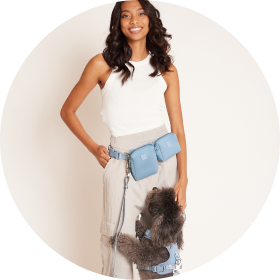- Home
- The Daily Wag!
- Senses
- Can Dogs Know How to Play Frisbee Toss?
Can Dogs Know How to Play Frisbee Toss?
Introduction
Most dogs love a good old-fashioned game of fetch, but throwing a Frisbee for your furry friend to catch and return to you can take this classic canine pastime to a whole new level. However, playing Frisbee probably won't come naturally to your fur-baby.
While dogs with strong retrieval instincts and a desire to please won't have any trouble chasing and returning any object you throw, teaching your dog that you actually want them to catch a flying disc can be a complicated process. Read on to find out how to start wowing friends and family with your pet's impressive Frisbee-catching skills.
Signs Your Dog Wants to Play Frisbee
What makes a good Frisbee dog? How can you tell whether your dog will love flying through the air and snatching a flying disc out of the sky with their teeth?
Well, there's no special formula that can help you tell a dog that will love Frisbee from a pooch that will turn their nose up at anything you throw, there are a few telltale signs that can indicate a dog who will excel at this fun sport.
One of the key indicators is if your dog loves a game of fetch. If your pooch goes tail-waggingly crazy for a simple game of fetching a tennis ball and bringing it back to you, that's a good base to build from. Dogs aren't particularly subtle when suggesting a game of fetch — they'll dump an object at your feet and make it very clear what they want you to do with it — and their excited, happy body language reveals just how much they're enjoying themselves.
As catching a Frisbee requires a certain amount of athletic ability, you'll also need to take a closer look at your pet's sporting skills. As well as energy levels and general fitness, consider how adept your pooch is at jumping and catching objects. If they've got all these basic skills, there's a good chance they'll be right at home soaring through the air to catch a Frisbee.
The Science of Dogs Loving Frisbee
If you've ever watched a dog down at your local park playing Frisbee, you'll be well aware just how much some pooches adore what is essentially a simple game. With anticipation etched all over their face and body language that oozes excitement, Frisbee fanatics can't wait for the next disc to be thrown so they can launch themselves skywards and pluck it from its trajectory.
But why? What is it about catching a disc that some dogs find so appealing?
The answer probably has a lot to do with genetics. For generations, humans have bred dogs to perform a variety of duties, many of which relied on strong retrieval instincts. From Labradors to Pointers and Poodles, there's a long list of breeds that were developed for the purpose of fetching items and returning them to their owner. This made them effective hunting companions whose job it was to retrieve ducks and other game, and dogs were chosen because of their strong prey drive, general athletic ability and desire to please their owner.
And it's this natural instinct to retrieve and to please that the sport of canine disc taps into. It's not something every dog will take to straight away, but it's a highly enjoyable way to pass the time for many of our furry friends.
Of course, if you and your pet are to become a successful Frisbee-playing partnership, you'll probably need to provide some guidance to help your pet understand exactly what you want them to do.
Training Your Dog to Play Frisbee Toss
Some dogs will take to playing with a flying disc like the proverbial duck to water. Others will require a little more training and assistance before they understand how the game works.
Once you've purchased a Frisbee designed especially for dogs, you'll be ready to start the training process. The first step is to introduce the disc to your dog; some will be fascinated and obsessed with it straight away, while others may need treats or encouragement to help pique their interest.
Next, start with some gentle, low-key games to get your pooch used to catching and retrieving the disc. You can play tug of war and encourage your dog to reach for the disc as you gradually hold it higher up, remembering to always reward your pooch and offer plenty of praise for doing the right thing.
Then, start rolling your disc along the ground, teaching your pet to chase and retrieve it. Don't forget to keep offering rewards when they bring it back to you.
The final part of the process is often the longest and is when you start throwing the Frisbee in the air. Start with short-range throws at an easy catching height, but remember to throw it near your dog, not directly at them. Over time, your dog will hopefully go from waiting for the Frisbee to hit the ground to impatiently snatching it out of the air. You'll then be ready to graduate to longer throwing distances and higher tosses.
Labrador Retrievers, German Shorthaired Pointers, Australian Shepherds and Border Collies regularly feature on lists of the best Frisbee dogs, but breeds of all shapes and sizes can be taught to love the sport. However, you'll soon be able to work out whether your dog is interested, or whether they'd rather devote their energy elsewhere.
Just remember that all dogs learn differently and at their own pace, so be prepared to mix it up and take things slowly. If you adopt a patient approach and keep training sessions short and focused, you'll set your pet up for the best chance of success.
Written by a Labrador Retriever lover Tim Falk
Veterinary reviewed by:
Published: 05/04/2018, edited: 04/06/2020
More articles by Tim Falk
